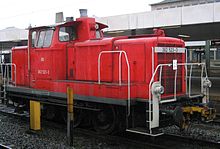Shunting locomotive

The shunting locomotive is a locomotive that, in contrast to the train locomotive, is not normally used to cover train journeys , but rather for journeys within a train station ( shunting ).
Shunting locomotives are specially adapted for their use and therefore usually have a central driver's cab and shunting steps on which shunting shunters can stay. It used to be powered by steam that was generated by combustion (series 80 or 81 ) or obtained externally by means of a steam accumulator , and later also by electric current that was supplied by the overhead line (series E 60 or E 63 ) and temporarily stored in accumulators was (series E 80 ).
In Germany today, shunting locomotives are driven almost exclusively by a diesel engine, so that catenary-free track sections of a train station, such as loading tracks, can be used. Exceptions are mainline locomotives with battery or diesel modules as so-called last-mile equipment ( Bombardier TRAXX 3 ) for shunting services or industrial railways ( Henschel EA 800 ).
In Switzerland, on the other hand, electric shunting locomotives are used almost exclusively, as almost all tracks there, including loading and side tracks, are spanned by an overhead line.
The drive of shunting vehicles is usually designed for a high starting tractive effort, not necessarily for a high top speed. Vehicles with different dimensions are used depending on the range of applications, ranging from small locomotives to large diesel engines with an engine output of over 1,000 kW (e.g. DB class 291 ). Shunting locomotives often have a very high dead weight for their size, as a higher friction weight enables a greater starting tractive effort.
In order to simplify the time-consuming coupling of the European screw coupling , many shunting locomotives have special automatic shunting couplings that latch into the draw hook on the wagon . A number of modern shunting locomotives have a remote control that allows the locomotive shunter to always occupy the top of the shunting department while driving. Instead of shunting locomotives, road- rail vehicles are often used for shunting on factory lines and connecting lines.
In addition to fully equipped locomotives, there are also shunting machines . These do not have a driver's cab and only consist of the drive unit and the coupling unit. Often these are designed as road-rail vehicles and are operated by remote control by the shunter. This type of vehicle is mostly used in industrial companies to move a few or individual vehicles. It would be uneconomical to operate a full-fledged shunting locomotive here.

